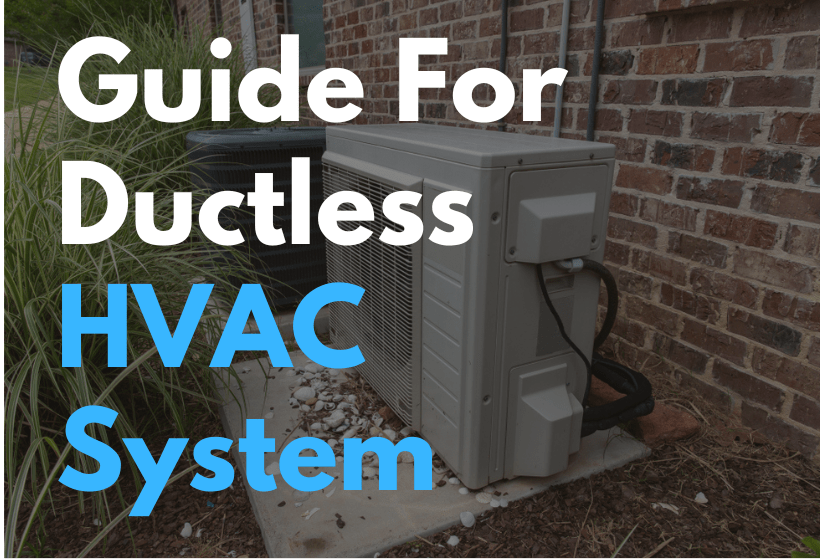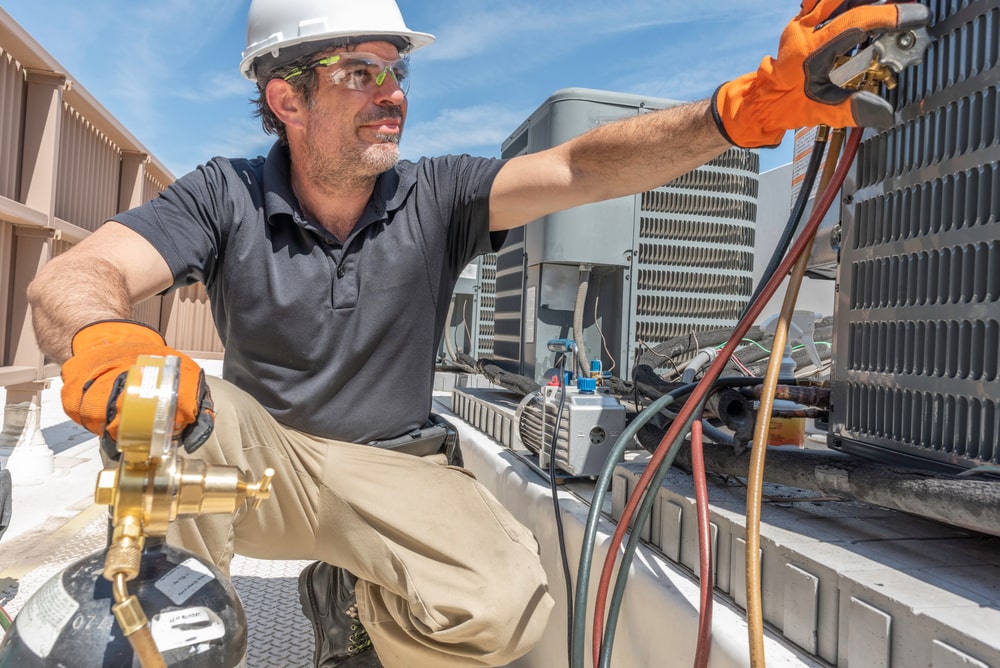Hey there, fellow comfort-seekers! We’ve all been there, right?
Stuck in the sweltering heat of summer or bundled up like an Eskimo in the dead of winter, desperately craving that sweet spot of perfect temperature in our homes. Well, fear not because we’re about to introduce you to a game-changer in the world of home climate control – ductless heating and cooling systems.
And hey, don’t let the fancy name scare you away; these things are way cooler than they sound! In this blog, we’ll tell you everything about the best ductless heating and cooling systems that you need to know. So, keep reading the blog and delve deep into the ductless wonders, where ordinary homes transform into perfect temperature harmony.
Diving into Ductless Systems
What Is a Ductless Heating and Cooling HVAC System?
Before we embark on our journey through the world of ductless heating and cooling systems for garages, let’s get down to the basics. What exactly is a ductless system, and how does it work its magic? Think of it as the ultimate comfort wizard for your home. A ductless system, also known as a ductless mini-split or simply a ventless HVAC system, is a climate control solution that operates without the need for traditional air ducts.
It’s like the modern, sleek alternative to the clunky, old-school HVAC systems you might be familiar with.
How Ductless Systems Work?
Now that you’ve unveiled the cloak of mystery around ductless systems, let’s peek behind the curtain and see how they work their enchanting spells. At the heart of a ductless system, you have two main components: an indoor unit and an outdoor unit. These two units work together in harmony to create the perfect climate in your home.
• Outdoor Unit
This is the workhorse of the operation. Think of it as your climate control command center. It’s usually placed outside your home, either on the ground or mounted on a wall. This unit is responsible for taking care of the heat exchange with the outside air.
• Cooling Mode
During the scorching summer months, the outdoor unit absorbs the hot air from inside your home and releases it outside.
• Heating Mode
When winter rolls around, the outdoor unit reverses the process. It absorbs heat from the outside air and brings it inside to warm your living space.
• Indoor Unit
This is the part of the system that ensures you feel the magic of comfort. You’ll find these indoor units mounted on walls, ceilings, or even concealed in some cases. They’re strategically placed in the rooms or areas you want to control.
• Distribution of Conditioned Air
The indoor units are responsible for distributing the perfectly conditioned air into your living spaces. They do this by blowing the treated air into the room, creating a comfortable oasis of temperature bliss.
• Individual Zone Control
Here’s where the real magic happens. Each indoor unit can be controlled independently. That means you can have one room set to a cool 70°F while another is a toasty 76°F. No more thermostat wars with your roommates or family members.
Benefits of Ductless Heating and Cooling HVAC System
Ductless systems come with a bag full of benefits. Their benefits will make you replace your old clunky HVAC system faster than you say “comfort.”
• Energy Efficiency
Ductless systems are champions of energy efficiency. By targeting a specific room, they can avoid the energy loss that comes with the ductless. With its help, you can say hello to lower utility bills.
• Zoned Comfort
With a ductless system, you’ve control over the different zones in your home. No more heating and cooling systems you’re using; your wallet will thank you, and so will the planet.
• Installation
Installation is a breeze compared to HVAC heating and cooling systems. You don’t have to tear walls or create intricate duct networks. It is like decorating a home with climate control.
• Air Quality
Ductless systems typically come with built-in air filters, ensuring that the air you breathe is as clean as a mountain breeze.
• Compact and Aesthetic
These units are sleek and modest, so they won’t mess up your interior design. You can even choose from different styles to match your decor.
• Year-Round Comfort
Ductless systems are versatile; they’ll keep you cool in summer and toasty in winter. It’s like having a personal climate butler on standby.
Disadvantages of Ductless Heating and Cooling HVAC Systems
Up to this point, you’ve seen a fairly positive picture of ductless heating and cooling systems, but ductless systems are not without their drawbacks. It’s time to highlight the less-than-glamorous aspects of these contemporary wonders. Get comfortable because we’re going to discuss some of their drawbacks.
• Upfront Cost
While ductless systems offer long-term time savings, they can be expensive to install as compared to traditional HVAC systems. Especially when you need to install multiple individual units in a large space or multi-zone controls.
• Noise Levels
Ductless systems are generally quieter than other HVAC systems, but they can still produce some noise when they’re not properly maintained. This noise can be a concern in the bedroom and other quiet places of the house.
• Maintenance
Ductless systems need proper and regular maintenance to ensure that they operate effectively. Filters need cleaning and replacement, while outdoor units should be free of debris. Forgetting to perform these tasks can lead to reduced efficiency and higher costs.
• Limited Range
Ductless systems are more suitable for individual rooms or single spaces. They might not be effective for larger spaces or entire houses. You will need to install multiple units, which can be costly for you.
• Climate Considerations
Ductless systems can be inefficient in providing heating in extremely cold weather, as they rely on getting heat from the outdoor air. In such regions, some of the supplementary heat sources are necessary, which can offset the energy savings.
• Limited Retrofitting
If you have an existing home and want to replace your old HVAC system with a ductless one, it can be expensive and hard to retrofit your entire house. You’ll have to compromise on some aspects, and it might not be cost-effective to install a ductless system in the new constructions and renovation.
DIY vs. Pro Installation
Now, you might be wondering if you need a team of experts to install these modern marvels. Well, you’ve two options.
• DIY
If you’re handy and have some knowledge about HVAC under your belt, a ductless system can be a DIY project. Just be sure to follow the instructions during the installation.
• Professional Installation
If you want to leave the installation to the pros, hiring an HVAC technician is the way to go. The professionals will ensure that everything is installed correctly and safely.
Ductless Heating and Cooling HVAC System Installation
So, you’ve decided to take the plunge into the world of ductless heating and cooling systems. Now, let’s embark on a journey through the installation process and get you on your way to ultimate comfort and efficiency.
• Initial Assessment
Before the installation, it’s crucial to conduct a thorough assessment of your home. It includes evaluating the layout, insulation, and identification of the room where you want to install a ductless system. In case you’re not sure where to start, hiring professional HVAC technicians will be helpful. They can provide you with expert guidance about the best placement for maximum efficiency.
• Sizing Matters
One size does not fit all when it comes to ductless systems. The next step is to determine the appropriate size of your indoor units. This involves considering the size of the room, its insulation, and its heating and cooling needs. An HVAC technician can perform assessments to ensure you get the right-sized units for optimal performance.
• Selecting Indoors and Outdoors
With sizing in hand, it’s time to select your indoor and outdoor units. Choose the units that match your aesthetic preferences and the specific needs of your room. Wall-mounted, cassette ceiling, and floor-mounted all have their advantages, so consider your space and design preferences when making your choices.
• Electrical and Refrigerant Lines
The installation process involves running electrical and refrigerant lines from the outdoor unit to the indoor units. This often requires drilling holes in walls or ceilings. The precise placement of these lines is crucial for efficient operation. The outdoor unit should be positioned in a location that allows for proper airflow and maintenance.
• Indoor Unit Mounting
Once the lines are in place, it is time to mount the indoor unit. This step requires careful attention to detail to ensure that each unit is securely fastened and leveled. Proper mounting is essential not only for performance but also for aesthetics.
• Testing and Commissioning
With everything in place, the system undergoes rigorous testing to ensure its functioning correctly. The technician will check for any leaks, ensure that the indoor units are delivering the desired temperature, and verify that the system is running smoothly in both heating and cooling modes.
• User Training
Before the technician wraps up the installation, they’ll provide you with training on how to use the system’s controls and settings. This includes how to set temperatures, adjust fan speeds, and make use of any additional features your ductless system may offer.
Final Thoughts
Remember, the world of HVAC is unique, diverse, and versatile, just like your comfort preferences and needs. So, explore your options, consult with the experts, and plunge into the world of ductless HVAC systems where you have the power to control the climate, room by room.
When it comes to professional consultation, HOMERIGHT Heating and Air Conditioning Inc. should be your first choice. We take the lead in providing you with exceptional services, from HVAC installation to maintenance. Don’t hesitate to contact us whenever you need our help regarding your HVAC system. Get ready to bid farewell to the temperature battles, higher bills, and inefficient heating and cooling. The future of comfort is ductless, and it is right at your fingertips.
Frequently Asked Questions
Do ductless systems heat and cool?
Yes, ductless systems offer both heating and cooling modes, making them versatile for year-round climate control.
How does ductless heating and cooling work?
Ductless heating and cooling systems work by using an outdoor unit to absorb or release heat from the outside air. Refrigerant circulates between the outdoor unit and one or more indoor units, which blow conditioned air directly into the desired space. This allows for individualized temperature control in different zones without the need for traditional air ducts, offering energy-efficient and flexible climate management.
Are ductless heating and cooling systems worth it?
Yes, ductless heating and cooling systems are worth it for all homeowners. They offer energy efficiency, zoned comfort, and precise control. While the upfront costs may be high, the long-term savings and improved comfort can make them valuable investments.





